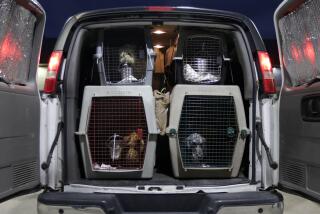Military’s dogs of war also suffer post-traumatic stress disorder
- Share via
LACKLAND AIR FORCE BASE, Texas — Not long after a Belgian Malinois named Cora went off to war, she earned a reputation for sniffing out the buried bombs that were the enemy’s weapon of choice to kill or maim U.S. troops.
Cora could roam a hundred yards or more off her leash, detect an explosive and then lie down gently to signal danger. All she asked in return was a kind word or a biscuit, maybe a play session with a chew toy once the squad made it back to base.
“Cora always thought everything was a big game,” said Air Force Tech. Sgt. Garry Laub, who trained Cora before she deployed. “She knew her job. She was a very squared-away dog.”
But after months in Iraq and dozens of combat patrols, Cora changed. The transformation was not the result of one traumatic moment, but possibly the accumulation of stress and uncertainty brought on by the sharp sounds, high emotion and ever-present death in a war zone.
Cora — deemed a “push-button” dog, one without much need for supervision — became reluctant to leave her handler’s side. Loud noises startled her. The once amiable Cora growled frequently and picked fights with other military working dogs.
When Cora returned to the U.S. two years ago, there was not a term for the condition that had undercut her combat effectiveness and shattered her nerves. Now there is: canine post-traumatic stress disorder.
“Dogs experience combat just like humans,” said Marine Staff Sgt. Thomas Gehring, a dog handler assigned to the canine training facility at Lackland Air Force Base, who works with Cora daily.
Veterinarians and senior dog handlers at Lackland have concluded that dogs, like humans, can require treatment for PTSD, including conditioning, retraining and possibly medication such as the anti-anxiety drug Xanax. Some dogs, like 5-year-old Cora, just need to be treated as honored combat veterans and allowed to lead less-stressful lives.
Walter Burghardt Jr., chief of behavioral medicine and military working-dog studies at Lackland, estimates that at least 10% of the hundreds of dogs sent to Iraq and Afghanistan to protect U.S. troops have developed canine PTSD.
Cora appears to have a mild case. Other dogs come home traumatized.
“They’re essentially broken and can’t work,” Burghardt said.
There are no official statistics, but Burghardt estimates that half of the dogs that return with PTSD or other behavioral hitches can be retrained for “useful employment” with the military or law enforcement, such as police departments, the Border Patrol or the Homeland Security Department.
The others dogs are retired and made eligible for adoption as family pets.
The decision to officially label the dogs’ condition as PTSD was made by a working group of dog trainers and other specialists at Lackland. In most cases, such labeling of animal behavior would be subjected to peer review and scrutiny in veterinary medical journals.
But Burghardt and others in the group decided that they could not wait for that kind of lengthy professional vetting — that a delay could endanger those who depend on the dogs.
Since the terrorist attacks of 2001, the military has added hundreds of canines and now has about 2,500 — Dutch and German shepherds, Belgian Malinois and Labrador retrievers — trained in bomb detection, guard duty or “controlled aggression” for patrolling.
Lackland trains dogs and dog handlers for all branches of the military. The huge base, located in San Antonio, has a $15-million veterinary hospital devoted to treating dogs working for the military or law enforcement, like a Border Patrol dog who lost a leg during a firefight between agents and a suspected drug smuggler.
“He’s doing fine, much better,” the handler yelled out when asked about the dog’s condition.
Cora received her initial training here and then additional training with Laub at Moody Air Force Base in Georgia. Before they could deploy, however, Laub was transferred to Arkansas, and Cora shipped off to Iraq with a different handler, much to Laub’s regret.
“I’ll always remember her as the girl who got away,” Laub said. “She and I had clicked so well.”
The bond between handlers and military working dogs is legendary. Army 1st Sgt. Casey Stevens has a catch in his voice when he mentions Alf, the German shepherd with whom he deployed to Iraq. Alf survived the war and died in the U.S. of natural causes.
“He saved my life several times; he had my back,” Stevens said. “Some guys talk to their dogs more than they do to their fellow soldiers. They’re definitely not equipment.”
“Equipment” is a kind of dirty word among dog handlers. In the Vietnam War, the military left behind hundreds of working dogs, determining that they were excess equipment. That will never occur again, military officials promise.
But when some of the current generation of war dogs returned to the U.S., their handlers noticed the lingering effects of battle.
Stevens has seen once-confident dogs freeze up when going through an easy training exercise. “They would just shut down,” he said. “I think they were going through memories.”
Just why Cora’s behavior changed is unknown. One possibility is that she sensed the apprehension of her handler or other troops around her — that classic battlefield concern that after months of survival, your luck is running out. A working dog has been trained to understand and even anticipate the handler’s needs and moods.
“There’s a saying in canine handling: Your emotion goes ‘down the leash,’” Laub said. “The handler’s stress goes right to the dog.”
Calling Cora’s condition canine PTSD drives home a point that Burghardt feels is key: “This is something that does not get better without intervention.”
Two factors slowed down the decision to label canine PTSD. For one, Burghardt and others did not want to suggest disrespect for the military personnel who have been diagnosed with the disorder.
Second is the problem faced by any veterinarian. “You can’t ask them questions,” Burghardt said.
The goal is to “rebuild and recondition” an afflicted dog, said Air Force Tech. Sgt. Charles Rudy, instructor supervisor at the dog training school.
“It’s really counter-conditioning,” Rudy said. “You find out what the dog doesn’t enjoy and then find what will overpower that.”
If the dog is afraid of the dark, exercises involve a decreasing amount of light, with the dog given treats and positive reinforcement each time it successfully enters a dimly lighted space. The same approach is used if the problem involves places that are noisy or crowded with people.
At a compact 60 or so pounds, Cora is fit and bright-eyed, her coat is shiny and she can still outrun most other dogs. Thanks to retraining and shielding her from battle, she has calmed down somewhat.
She no longer snarls at other dogs. But neither does she anticipate her handler’s orders or quiver with excitement at the idea of sniffing out hidden explosives. Like many a human veteran, Cora is marked forever by having gone to war.
One recent day, Cora appeared to work well with Cpl. Drew Daniel Adams, a trainee from the Marine base in Yuma, Ariz. Cora stayed close by Adams but gave off a vibe to other humans of “don’t get too close to me.”
Sometimes Cora will appear to respond to a command and then decide that, no, she would rather sit down and rest.
“Sometimes she just doesn’t do what she’s asked,” Rudy said. But her occasional moodiness makes her an excellent trainer of trainers. “It’s beneficial because [the trainees] get to see not just when things are working right, but when things aren’t working. That increases their skills.”
Trainees admire Cora as a combat veteran. But admiration and affection may be two different things.
Asked about whether the trainees like Cora, Rudy laughed. “I can’t say specifically, but I’m willing to bet they don’t appreciate her quirks at first.”
If Adams cannot control Cora, he might not pass the course. Better that Adams or any trainee wash out now rather than be unable to work with a balky dog in Afghanistan.
“Cora has proven a challenge for him and that’s good,” Gehring said. “Cora is still working for us.”
Another thing about Cora hasn’t changed. She still loves a pat on the head or a biscuit, reminders of a younger dog who seemed to see everything as a game.
More to Read
Sign up for Essential California
The most important California stories and recommendations in your inbox every morning.
You may occasionally receive promotional content from the Los Angeles Times.










